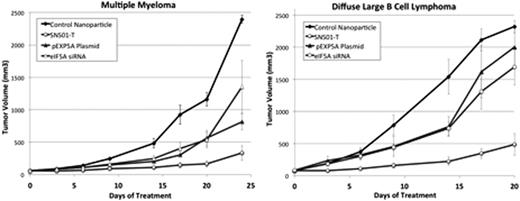Abstract
SNS01-T is a novel nanoparticle that is designed to selectively initiate apoptosis in B-cell cancers such as multiple myeloma and non-Hodgkins B-cell lymphomas. SNS01-T comprises a plasmid DNA (pExp5A) encoding a pro-apoptotic form of the eukaryotic translation initiation factor 5A (eIF5A) containing a single-point mutation that prevents hypusination, an eIF5A siRNA that inhibits expression of the pro-survival hypusine-eIF5A protein, and a polymer that serves to assemble the nucleic acids into a nanoparticle. SNS01-T is currently being investigated in a multi-site, open-label Phase1b/2a dose escalation study in subjects with relapsed or refractory multiple myeloma (MM), mantle cell lymphoma (MCL), or diffuse large B cell lymphoma (DLBCL).
SNS01-T has demonstrated activity in MM xenograft models as well as in B cell lymphoma models of MCL and DLBCL, when administered twice weekly at doses ≥ 0.18 mg(nucleic acid)/kg. In this study we compared the ability of SNS01-T to transfect, regulate eIF5A expression, and kill MM, DLBCL, and MCL cell lines. Furthermore, the activity of SNS01-T in normal B cells was investigated. A previous study using a KAS-6/1 MM xenograft model demonstrated that the eIF5A siRNA and plasmid pExp5A both have anti-tumoral activity in MM but had a greater impact on tumour growth when combined together as SNS01-T. This finding was confirmed in this study in a second MM model (RPMI 8226) as well as in a DLBCL xenograft model.
To determine the efficiency of SNS01-T transfection into malignant or normal B cells, the pExp5A plasmid and eIF5A siRNA were labeled with FITC and DY547, respectively, packaged into nanoparticles using polyethylenimine polymer, and used to transfect cultured cells. FACS analysis was used to determine the percent of the cell population transfected with plasmid, siRNA, or both. RT-qPCR was used to assess biological activity of SNS01-T by quantifying the expression of eIF5AK50R mRNA transgene and endogenous eIF5A mRNA in a variety of B cell lines. The IC50 of SNS01-T in a panel of MM, MCL, and DLBCL cell lines was determined by XTT assay. SCID mice bearing either RPMI 8226 MM tumours or SuDHL6 GCB DLBCL tumours were treated with pExp5A plasmid (formulated with PEI and control siRNA), eIF5A siRNA (formulated with PEI and a control plasmid), or SNS01-T at 0.375 mg/kg twice per week by intravenous injection.
SNS01-T was able to transfect MM, MCL, and DLBCL cell lines, although the proportion of cells transfected with both plasmid and siRNA was higher in MM cells. Transfection of SNS01-T resulted in expression of the transgene as well as a statistically significant reduction in expression of eIF5A mRNA compared to untreated controls for all three cell types. In contrast, normal B cells were found to take up fluorescently-labeled SNS01-T with reduced efficiency compared to RPMI 8226 MM cells. Futhermore, SNS01-T was observed to induce cell death in RPMI 8226 MM cells but not in normal B cells.
In the RPMI 8226 xenograft model, treatment with either the pExp5A plasmid alone or eIF5A siRNA alone resulted in a 66 % reduction (p < 0.0001) or 44 % reduction (p < 0.05) in tumor volume compared to the control group at day 24 of the study. In contrast, treatment with SNS01-T, which contains both the pExp5A plasmid and the eIF5A siRNA, resulted in an 86 % (p < 0.0001) reduction in tumor volume. A similar result was observed in the SuDHL6 model with a 14 % reduction or 27 % reduction (p < 0.05) in tumor volume compared to the control group at day 20 of the study following treatment with pExp5A plasmid or eIF5A siRNA, respectively. In contrast, treatment with SNS01-T resulted in a 79 % (p < 0.0001) reduction in tumor volume.
Collectively, these preclinical studies indicate that SNS01-T therapy has significant potential against MM, MCL, and DLBCL.

Taylor:Senesco Technologies: stock options Other. Dondero:Senesco Technologies: Employment. Thompson:Senesco Technologies: Consultancy, Equity Ownership, Membership on an entity’s Board of Directors or advisory committees, Research Funding.
Author notes
Asterisk with author names denotes non-ASH members.

This feature is available to Subscribers Only
Sign In or Create an Account Close Modal